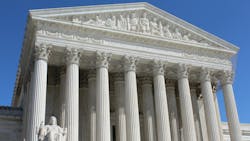Supreme Court’s Decision Seen Changing Rulemaking
Commentary/Analysis
This was a momentous term for the U.S. Supreme Court, not the least by upholding the principle of presidential immunity, stirring up great controversy. Another decision that gained a fair amount of media attention was the court’s overturning of the Chevron doctrine, which previously had held that courts should show deference to the expertise of federal agencies when adjudicating the legality of the regulations they produce.
However, the Loper Bright decision—as the case that upended the Chevron doctrine is called—may not have as much of an impact as some have suggested. In the end, federal judges, including those sitting on the Supreme Court, could come to regret this decision for clogging up their already-crowded dockets with a flood of litigation.
“With Loper Bright as a resource, employers are better equipped to strategically challenge agency action lacking clear legislative authority,” points out Phillip Walters, an attorney with the Akerman law firm. “The new test shifts the burden to the federal district courts to determine if agencies have acted within their statutory authority, but the Supreme Court has sent the strong message that agencies will no longer have the benefit of unrestrained deference.”
He believes that this eventually will be seen as a net positive when everything shakes out. “With this pendulum swing back to the federal courts for independent statutory interpretation, many employers should brace for uncertainty, but potentially less volatility and susceptibility to political influences in the long term.”
There is no denying that the new precedent set by the High Court will change how future suits aiming to undo federal rulemakings are developed and defended. In the future, agencies also could be discouraged from writing the kinds of rules that are seen stretching out of shape the plain language of laws adopted by Congress.
“Rules will now be easier to challenge, especially when they stray far from the statutory text,” according to attorneys Alexander MacDonald and Michael Lotito of the Littler Mendelson law firm. “So agencies might have to write narrower rules and look for other ways to advance their policy positions.”
The policymakers at those federal agencies might end up choosing to file more lawsuits to establish their interpretations in court, and they may choose to look for friendlier venues to file those lawsuits to improve their chances, MacDonald and Lotito suggest. “In short, they may regulate more modestly and litigate more strategically.”
One of the regulations that could be in immediate trouble is the recently adopted Occupational Safety and Health Administration (OSHA) rule requiring employers to allow an employee to request that a non-employee (i.e., union representative) to tag along on an agency workplace inspection, a controversial action that is already being challenged in court.
Other regulatory actions that could be affected include the Department of Labor (DOL) rules increasing the minimum salary threshold for application of the “white collar” exemptions to federal minimum wage law and redefining an independent contractor vs. statutory employee, according to Stephanie Adler-Paindiris and Patricia Anderson Pryor, attorneys for the law firm of Jackson Lewis.
A target rich environment also has been created by the leadership of the National Labor Relations Board (NLRB) as it has pushed its zealous campaign to promote unionization. Under the Biden administration, the board’s identity has switched from being a broker of disputes between labor and management to becoming an advocate for the nation’s unions, twisting the NLRB’s enabling law out of all recognition, its critics hold.
Overreach Examples Abound
Since the very first day of the Biden administration, the leadership of federal agencies have stretched the boundaries of what was considered allowable under law by previous administrations, particularly when it comes to helping its political allies in the nation’s labor unions to fulfill their agendas. This included a cabinet-level task force to create a strategic plan, formal agreements between agencies to coordinate their activities to meet union policy goals, as well as aggressively mounting similarly intentioned rulemaking schemes.
Examples of what are considered by some to be the NLRB’s overreach are its joint employer decision and determination that it can order employers when found to have engaged in unfair labor practices to be automatically unionized regardless of how employees voted in an organizing campaign. These and other decisions have tipped the scales in the favor of unions and against nonunion employers.
“Opportunities for employers to successfully challenge overly broad rules and regulations are now plentiful and ripe,” notes Walters. Other recent rules which will almost certainly be susceptible to challenge he says include the pro-union regulations recently issued by the NLRB and other agencies. He also cites new compliance requirements for discrimination and harassment issued by the Equal Employment Opportunity Commission (EEOC).
One of these is the recent EEOC decision that stretched the Pregnant Workers Fairness Act (PWFA) to require accommodations for medical conditions related to abortion, point out Adler-Paindiris and Anderson Pryor. Even before the Loper Bright decision, 17 state attorneys general already had filed suit challenging the rule’s abortion provisions.
Another rule that the precedent is expected to impact is the recently adopted Federal Trade Commission (FTC) rule banning employers from imposing noncompete agreements on their employees that was adopted earlier this year and is slated to go into effect in September, and which also faced court challenges as soon as it was announced prior to Loper Bright.
FTC Chairman Lina M. Khan led her agency into taking action on this and other labor issues by claiming that such actions come under its core responsibility of promoting competition and enforcing antitrust laws. Her legal justification for the noncompete agreement ban rests on the commission’s taking the part of enabling legislation, where Congress granted the commission the authority to make rules regarding procedural matters. Those who are challenging the rule in court charge that this distorts the real meaning of the law and violates the legislative intent of Congress.
A federal district court judge in Texas saw merit in this argument and handed down a temporary restraining order, but in regard to the case he is hearing. It still applies to all other employers. It remains to be seen how the other courts that are hearing similar cases will react under the new Supreme Court decision, but some attorneys believe it may make the commissioners blink before acting again in the future.
“This decision greatly undermines the FTC’s rulemaking authority, which makes it more likely that the final rule’s effective date will be delayed and/or it may never go into effect,” assert attorneys with the law firm of Thompson Hine.
However, attorney Kendra D. Simmons of the law firm of Fredrikson & Byron warns that there is no guarantee that the non-compete rule will be overturned before it goes into effect in two months. “Employers should evaluate their risk tolerance and develop a structured game plan for compliance as Sept. 4 approaches,” she says, adding, “Perhaps that game plan includes filing legal challenges of their own.”
Other federal agency actions that are seen as potential targets under the High Court ruling are the Environmental Protection Agency’s air quality directives and the Department of Transportation’s vehicle emission standards.
Many legal analysts believe that the original Chevron decision was adopted by the Supreme Court 40 years ago in an effort to reduce the flood of litigation clogging the courts that arose from public opposition to proliferating federal rulemakings. In addition, some plaintiffs and defendants might have good reason to wish that judges did not try to insert themselves into what can be complicated and confusing technical matters that are beyond their ken. Even the august Supreme Court has been known to falter occasionally in this regard.
About the Author

David Sparkman
founding editor
David Sparkman is founding editor of ACWI Advance (www.acwi.org), the newsletter of the American Chain of Warehouses Inc. He also heads David Sparkman Consulting, a Washington D.C. area public relations and communications firm. Prior to these he was director of industry relations for the International Warehouse Logistics Association. Sparkman has also been a freelance writer, specializing in logistics and freight transportation. He has served as vice president of communications for the American Moving and Storage Association, director of communications for the National Private Truck Council, and for two decades with American Trucking Associations on its weekly newspaper, Transport Topics.
